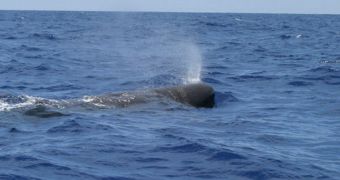Scientists are aware of the dramatic environmental impact the oil slick is having on the Gulf of Mexico ecosystem. In addition to killing wildlife on the surface, in protected areas, and starving areas in the deep ocean of oxygen, the crude is also posing an increasing threat to the already-dwindling whale population residing in the Gulf of Mexico. As such, experts are taking steps to survey the situation, by installing underwater microphones to listen for the songs these intelligent animals make.
The microphone array is going to be used as a source of information on where the whales meet up, their numbers, as well as their health. “Night after night, on TV and on webcams, we saw oil spewing from the bottom of the ocean. You wonder, 'What can we do? What's the impact of this?' In the case of marine mammals, we don't know because we don't even know what's there,” says expert Christopher Clark, who is based at the Cornell University Lab of Ornithology. He is also the head of the Bioacoustics Research Program (BRP) team there, LiveScience reports.
“Since whales use sounds as a communication, by listening we can tell what species are there, when they are there, and in some cases what are they doing,: explains the science director of the BRP, Aaron Rice. He says that the main objective of the new study will be listening to sperm whales and Bryde's whales. These animals have been identified by the US National Oceanic and Atmospheric Administration (NOAA) as being endangered and threatened by the Deepwater Horizon oil spill. Humpbacks and right whales are not targeted because they do not visit the Gulf all the time. They only come to visit occasionally, investigators say.
The Cornell team installed about 22 microphones, at depths ranging between 700 and 1,000 meters (2,900 and 3,200 feet), in an arc-like formation alongside the US continental shelf. The devices are known as marine autonomous recording units, and they are capable of picking up the strong acoustical signals whales send to communicate with each other.
Since April 20, when the Deepwater Horizon semi-submersible drilling rig exploded, killing 11, thousands of barrels of crude oil have been leaking into the waters of the Gulf of Mexico. The oil slick has extended considerably in the months that passed, and has already affected large swaths of delicate coastal areas. Underwater plumes have entered the Loop Current, which is a deep-water current that heads east, towards Florida, and then even further, into the Gulf Stream. Since April 22, when the rig sunk, British Petroleum, the company in charge of operating the platform, has been struggling to contain the situation with federal help, but thus far efforts have been less than successful.

 14 DAY TRIAL //
14 DAY TRIAL //